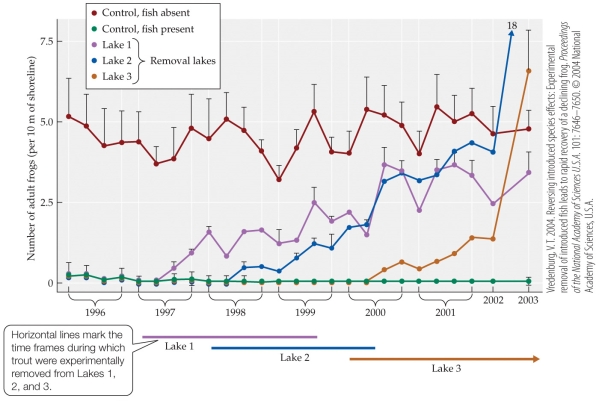Refer to the figure. Vredenburg studied the impact of the introduction of rainbow and brook trout on a species of amphibian, the mountain yellow-legged frog (Rana muscosa) . After showing greatly decreased frog populations in lakes with trout, he set up an experiment using three categories of lakes: lakes from which he removed trout, lakes that had never had trout, and lakes that still contained trout. He compared the number of adult frogs per 10 m of shoreline in all groups, as shown in the figure. What is the most likely reason that Vredenburg chose to use a large-scale experimental design such as this, rather than a single lake or laboratory experiments?
Vredenburg studied the impact of the introduction of rainbow and brook trout on a species of amphibian, the mountain yellow-legged frog (Rana muscosa) . After showing greatly decreased frog populations in lakes with trout, he set up an experiment using three categories of lakes: lakes from which he removed trout, lakes that had never had trout, and lakes that still contained trout. He compared the number of adult frogs per 10 m of shoreline in all groups, as shown in the figure. What is the most likely reason that Vredenburg chose to use a large-scale experimental design such as this, rather than a single lake or laboratory experiments?
A) The larger design allowed Vredenburg the ability to do replications.
B) A smaller study would not adequately answer the experimental question.
C) In a larger study, it is easier to manipulate the various experimental treatments.
D) In a real-world situation such as this, all variables can be more easily controlled.
Correct Answer:
Verified
Q58: A scientist monitors both the pollution entering
Q59: Many species live in the Quabbin Reservoir
Q60: One ecologist is studying the genetic changes
Q61: Which statement is not correct in regards
Q62: Which of the following is an abiotic
Q63: In a desert ecosystem, plants capture 120
Q64: Refer to the figure. Q66: Refer to the figure. Q67: Biologists find that tomato plants treated with Q68: Refer to the figure. Unlock this Answer For Free Now! View this answer and more for free by performing one of the following actions Scan the QR code to install the App and get 2 free unlocks Unlock quizzes for free by uploading documents![]()
![]()
![]()

